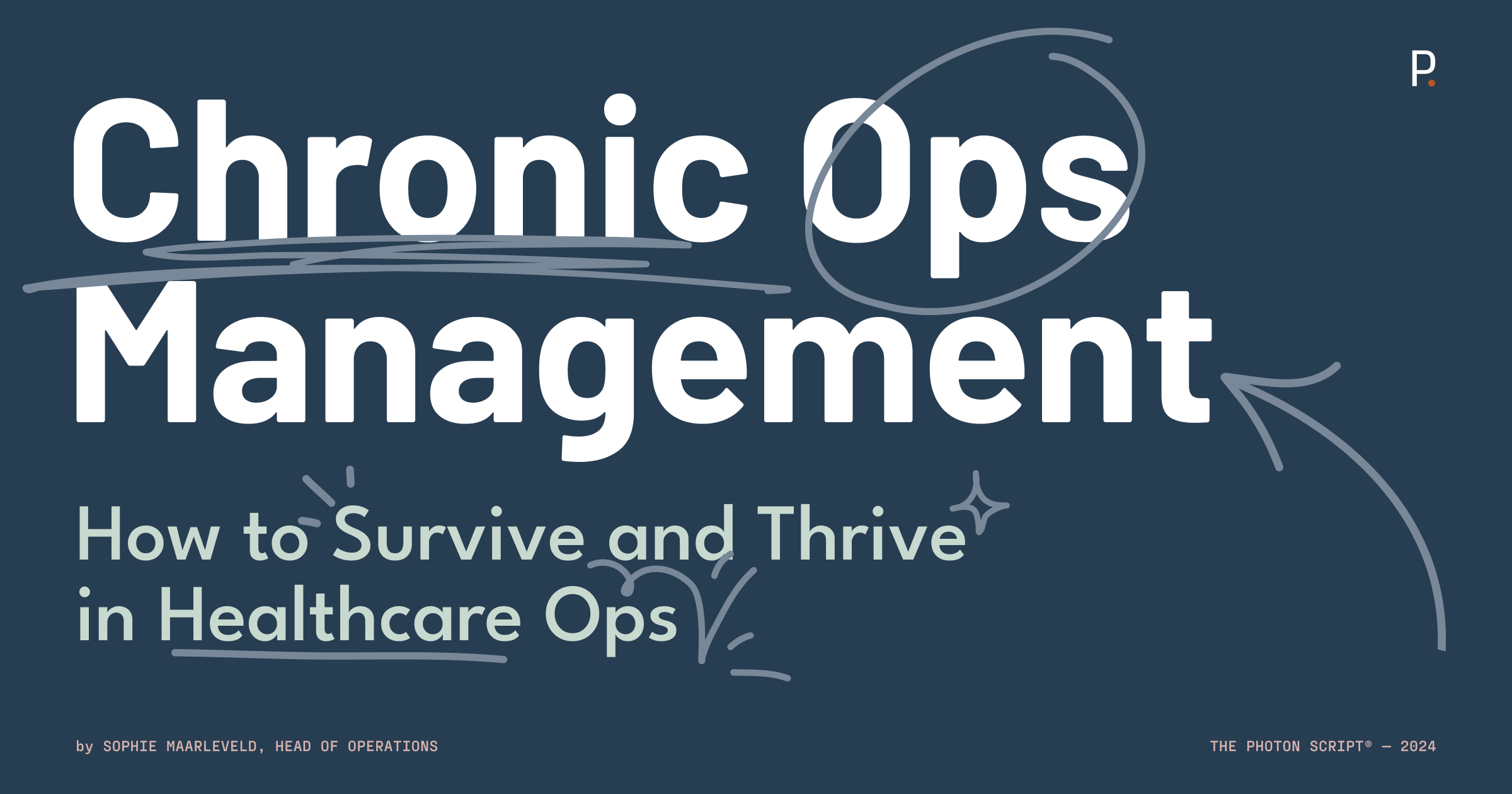Chronic Ops Management: How to Survive and Thrive in Healthcare Ops
So, what's an ops leader to do? Here are four strategies that have consistently moved the needle.

Diagnosis: Operational Challenges
Before joining Photon as Head of Operations, I spent six years building and managing customer and clinical operations teams for digital care delivery companies. Fellow Ops leaders, you know what it’s like—these functions are the lifeblood of our organizations. You've lived the late nights spent crafting capacity models, fine-tuning workflows, and raising impassioned pleas for product and process changes that let your teams do more with less.
Let's be real—it's a Herculean task, especially in ambitious healthcare startups where technical resources for internal tooling are limited or non-existent, and every new initiative needs to be supported operationally until it’s at scale. Balancing expansion with cost containment often feels like you're trying to square the circle.
Now at Photon, I get to play a role in supporting and streamlining operations for other healthcare providers and startups. We're not just solving our own operational challenges, but partnering with a broad ecosystem of healthcare innovators to tackle the complex ops problems created by prescription management.
So, what's an ops leader to do? Here are four strategies that have consistently moved the needle for me:
Treatment: Four Efficiency Boosters
1. The BPO Gambit
Business Process Outsourcing—the offshore cavalry! For many of us in care delivery and service-focused companies, building a call center is unavoidable. Doing it in-house? Expensive, time-consuming, and challenging to scale.
Offshore BPO agents can cost as little as a third of a US-based agent without the headache of recruiting, payroll, and management overhead. I've run the gauntlet with BPOs—evaluated more than I can count and worked with a small army of them. I've seen the good, the bad, and the "how is this even possible?"
If you're looking to reduce labor costs while keeping that human touch (because let's face it, in healthcare, going full robot doesn’t work), this could be your play. That said, the right partner is critical. Before committing, clearly define your criteria and consider:
- Capabilities: Can they handle complex healthcare workflows?
- Cost: Is the pricing sustainable and truly cost-effective? What is included in the cost-per-agent and what will you need to continue to resource in-house?
- Quality: Will they maintain your standards of patient care?
- Flexibility: Can they adapt to your changing needs?
- Culture: Will they integrate well with your existing team?
- Security: Can they meet healthcare data protection requirements?
Remember, what works for one company might not work for yours. Do your due diligence and don't hesitate to thoroughly vet potential partners.
2. Off-the-Shelf Tools: The Hidden MVPs
It's remarkable what you can achieve with most customer service platforms if you're willing to roll up your sleeves and get under the hood. From chatbots that actually chat, to automated responses and advanced routing logic, you can often make massive strides without having to beg, borrow, or steal time from Product or Engineering. When Ops demonstrates the ability to increase efficiency independently, it often strengthens the case for technical support when needed. It screams, "We've MacGyvered the heck out of what we've got. Now imagine what we could do with some real firepower.”
An investment in your off-the-self tools is essential if you want to make this work. You need to either spend the time yourself, hire someone with deep experience using that tool, or designate someone on your team to go deep. I also have a strong preference for partnering with companies that invest in product support resources—something to think about it your shopping around for a tool!
3. The AI Adventure
My first experience with an AI vendor was just a few short years ago. We were piloting a solution that was supposed to revolutionize our support team. The result? It could barely handle tasks our outsourced agents did in their sleep and it cost more than it saved.
Fast forward to today at Photon, and it's a different world. By automating key processes, AI is empowering us to scale rapidly without sacrificing the agility and creativity that define us as a product and as a vendor.
AI has a ton of potential but it’s also not free—it has to create more value than it costs. The real challenge is figuring out where an AI solution can move the needle on unit economics without reducing service quality and undermining your credibility with patients and partners. To move quickly and confidently with AI, you need to know exactly which metrics you want to impact and have a crystal clear picture of what success looks like and how quickly you want to achieve it.
4. The Product Partnership
At Photon, our entire team is accountable for unit economics goals—we’re all aligned on the importance of building a scalable and self-sustaining product and service. The speed and impact of our product and engineering teams optimizing operations has been unlike anything I've seen in my career.
But I've also worked in places where cost-saving projects are considered as exciting as watching paint dry, and trying to get buy-in from tech counterparts feels like a fool's errand. I’ve combatted that by being ruthlessly analytical in my arguments and requests. I don't just present a problem—I serve it up with a side of cold, hard numbers. I’ve seen this approach deployed successfully by prospective Photon customers as they advocate for our tools internally.
For example: "Our clinicians are drowning in admin work, especially responding to calls and messages from patients and pharmacies about prescriptions. They're burning 50 hours a week on these tasks, which costs us $390,000 per year. If we can outsource, automate or eliminate these tasks, we'll be able to increase max patient panels size from X to Y, which would allow is to reduce our 2025 headcount requirements by 2 providers, saving up to $500,000."
Prognosis: Balancing the Ops Rollercoaster
The highs and lows of operations in healthcare startups are not for the faint of heart—I think you have to be a bit of an adrenaline junkie to thrive. But that mental and emotional roller coaster can be exhausting, and if there's a path to a more balanced existence, we should all be open to exploring it.
I can say from experience that these tactics have been real game-changers and have allowed me to find that balance, both in my previous roles and now at Photon in service of care delivery trailblazers. Put them to work for your organization and you just might be surprised by the operational efficiency gains you can unlock, the relationships you build, and the newfound capacity to focus on the more exciting, high-impact work that first drew you to this fast-paced world of healthcare innovation.


